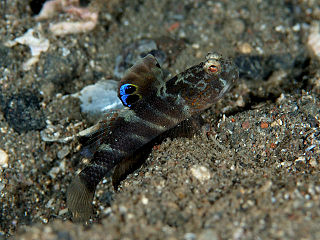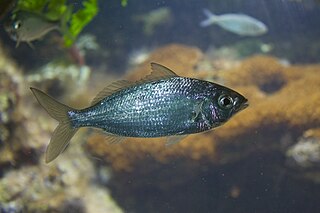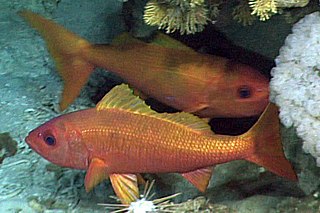
Abalistes is a small genus of marine ray-finned fishes belonging to the family Balistidae, the triggerfishes. These triggerfishes are found in the Indo-Pacific and eastern Atlantic. This genus contains two recognised species.

Pristipomoides filamentosus, also known as the crimson jobfish, rosy snapper, bluespot jobfish, crimson snapper, king emperor, king snapper or rosy jobfish, is a species of ray-finned fish, a snapper belonging to the family Lutjanidae. It is found in the Indian Ocean and in the Pacific Ocean as far east as Hawaii and Tahiti. This species is very important to local commercial fisheries and is sought out as a game fish--one of the Deep Seven species of Hawai'i.

The Aulopidae are a small family of aulopiform ray-finned fish. They are found in most tropical and subtropical oceans, and are commonly known as flagfins.

Mahidolia mystacina, the flagfin prawn goby, flagfin shrimpgoby or smiling goby, is a species of goby native to the Indian Ocean and the Pacific Ocean from Delagoa Bay, Mozambique to the Society Islands and from southern Japan to Samoa and northern Australia. This species occurs in marine and brackish waters, being found in coastal bays, estuaries and reef bases where the bottom is silty or muddy at depths of from 5 to 25 metres. This species is a commensal with a species of alpheid shrimp, using its burrow as its home. This species can reach a length of 8 centimetres (3.1 in) TL. This species can also be found in the aquarium trade. It was first discovered at the mouth of the Chanthaburi River, Amphoe Laem Sing, Chanthaburi Province, Eastern Thailand by H. M. Smith.
The blotchfin dragonet is a species of dragonet native to the Indian Ocean and the western Pacific Ocean. It also now occurs in the Mediterranean Sea, where it was first recorded in 1953 off Israel. It has since been observed in Cyprus, Lebanon, Turkey and Rhodes (Greece). This species occurs at depths from 16 to 350 m and can grows to a length of 20 cm.

Inimicus is a genus of marine ray-finned fishes, it is one of two genera in the tribe Choridactylini, one of the three tribes which are classified within the subfamily Synanceiinae within the family Scorpaenidae, the scorpionfishes and their relatives. These venomous, benthic fishes are found on sandy or silty substrates of lagoon and seaward reefs, in coastal regions of tropical oceans. The ten described species are collectively known by various common names, including ghoul, goblinfish, sea goblin, spiny devilfish, stinger, and stingfish.

Emblemariopsis is a genus of flagblennies found throughout the Atlantic ocean.

Hime is a genus of flagfins native to the eastern Indian Ocean and the western Pacific Ocean.

Icelinusis a genus of marine ray-finned fishes belonging to the family Cottidae, the typical sculpins. These fishes are found in the northern and eastern Pacific Ocean.

Eucinostomus is a genus of fish in the family Gerreidae. They are native to the Atlantic and Pacific coasts of the Americas.
John Ernest "Jack" Randall was an American ichthyologist and a leading authority on coral reef fishes. Randall described over 800 species and authored 11 books and over 900 scientific papers and popular articles. He spent most of his career working in Hawaii. He died in April 2020 at the age of 95.
Leptaulopus is a genus of flagfins native to the western Pacific Ocean, with these currently recognized species:

Pristipomoides is a genus of marine ray-finned fish belonging to the family Lutjanidae, the snappers. They are found in the Atlantic, Indian and Pacific oceans.

Randall's snapper is a species of ray-finned fish, a snapper belonging to the family Lutjanidae. It is native to the Indo-Pacific region.

Abalistes filamentosus, the hairfin triggerfish, is a species of marine ray-finned fish belonging to the family Balistidae, the triggerfishes. It is found in the Indo-Pacific Ocean and in subtropical waters. It lives in the Pelagic-Neritic zone of the ocean between 61–180 meters deep. It is harmless to humans.

Gerres filamentosus, the whipfin silver-biddy, flagfin mojarra or threadfin silver belly, is a fish native to the coastline of Africa and Madagascar east to Japan, Australia and New Caledonia.
Ceratomyxa yokoyamai is a myxosporean parasite that infects gall-bladders of serranid fishes from the Great Barrier Reef. It was first found on Epinephelus maculatus.

Tosanoides filamentosus is a species of reef fish from the subfamily Anthiinae part of the family Serranidae, the groupers and sea basses. native to the northwest Pacific Ocean around Japan and can be found in depths of 50–60 meters. Tosanoides filamentosus is one of six species that make up the genus Tosanoides and it is the type species of that genus.

Rhycherus filamentosus, commonly known as the tasselled anglerfish, is a species of frogfish endemic to southern Australia in the southwestern Pacific Ocean and southeastern Indian Ocean. It is a well-camouflaged predator and lies in wait on the seabed for unwary prey to approach too close.
Gobioclinus is a genus of labrisomid blennies from the coasts of the western Atlantic and eastern Pacific Oceans off the Americas.
2.Carvalho, A., M. Guy, C. Sampaio. 2010. "First report of Aulopus (Teleostei: Aulopidae) from Southwestern Atlantic with a review of records and a key to Western Atlantic Aulopoidei species". Zootaxa 2628:27-42.















